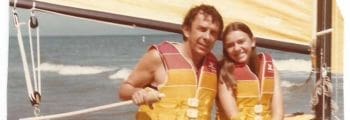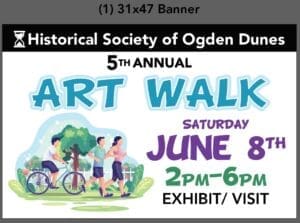1920s: “The Beginnings”

In the mid-twenties three external events influenced the development of Ogden Dunes. One, the completion of U.S. 12 “Dunes Highway” directly linked Chicago to southern Michigan. Two, the construction of the Burns Waterway (Ditch) directly east of Ogden Dunes that linked the Little Calumet River to Lake Michigan and drained the watershed south of Ogden Dunes. Three, Samuel Insull’s purchase and upgrade of the South Shore electric railway. 1923: Ogden Dunes, Inc., led by Samuel Reck and included Colin Mackenzie and Joseph Boo purchased over 500 acres from the estate of Francis Ogden. 1925: Alice…
Read more1930s: “Struggle for Survival: The Great Depression”

The Great Depression nearly marked the end of Ogden Dunes. The closure of the Ogden Dunes Ski Jump in 1932 was a major blow. The recovery, stimulated by the New Deal and the coming of World War II, led to the creation of an active community by 1940. 1930: Port Williams: port and steel mill proposed east of Burns Ditch 1930: The Census lists 50 full-time residents in 14 households 1930: The 2nd Subdivision was platted and recorded (Hillcrest on the east, Tamarack, Locust, Linden on the west and south). 1932: The Realty map shows…
Read more1940s: Becoming a Residential Community

World War II brought together the full-time residents and the owners of cottages. Nearly every family had a member who was called for military service. The community became united by the war effort. With the return of peace, Ogden Dunes became an attractive residential community for former GIs and their young families. New homes were affordable for the emerging middle class in America. 1940: The Census lists the 144 full-time residents residing in 45 households. The “Sandpiper” newsletter listed 30 children in the Portage Township schools. 1940: The plat map indicates 132 homes and cottages….
Read more1950s: A Residential Community and the Battle for the Dunes

In the 1950s the population continued to increase and new community organizations were formed to meet the needs of this residential community. At the same time Ogden Dunes and its residents struggled to prevent the complete industrialization of the lake shore both to its west and to its east. 1950: The Census indicates that the Town has a population of 429 full-time residents. The realty map listed 180 homes and cottages with the majority owned by full-time residents. The “Sandpiper” listed 80 K-12 students and 28 in college. 1950s: National Steel (Midwest Steel) began construction…
Read more1960s: “Turmoil and Resolution”

The 1960s began with the residents of the Town very divided over whether to cooperate with the industrial development to its east or to continue to fight what appeared to be an unwinnable battle. Ultimately, Congress imposed a compromise in 1966 that allowed industry to take nearly seven miles of shore line and dunes. This compromise also created the Indiana Dunes National Lakeshore to protect the dunes directly west and south of Ogden Dunes, as well as thousands of acres east of Bethlehem Steel and the electrical generating plant. 1960: The 1960 Census shows 947…
Read more1970s: “Thawing of Tensions”

For the United States the decade of the 1970s marked the end of the Cold War with the improvement of relations with both the U.S.S.R. and China. For the residents of Ogden Dunes the community came to accept its new neighbors – the Town of Portage, the National Lakeshore’s West Beach, the Port of Indiana and Midwest and Bethlehem Steel. At the same time, the growth of the Town was limited by the fact that only a few lots remained for building homes. 1970: The 1970 Census indicates the population of full-time residents is 1,361….
Read more1980s and After: “The Aging of the Community and the Efforts to Protect the Beach”

The population of Ogden Dunes peaked in 1990 with 1,499 residents. Since that time, given the absence of additional buildable lots and the natural aging of the population, the Town has evolved from a child-centered community to an adult-centered one. Despite the decrease in the population and its aging, the major community organizations remain active, including the Women’s Club, which celebrates it 80th year in 2018, the Home Association, the Volunteer Fire Department, the Community Church, the Lions’ Club, the Historical Society, the Sandpiper Co-op Nursery, and the Prime Timers. Also since the 1970s, with…
Read moreProgram on Genealogy Basic, March 21, 2021
Just a reminder…. – this Sunday March 21, 2021 at 2p CT Online https://depaul.zoom.us/j/97456252454 or by phone 312 626-6799 – Meeting ID: 974 5626 2454 On your computer just click on the colored https above or paste it in your browser and you can see the live presentation or phone in to hear it.
Read more100 Things to Do
The Historical Society of Ogden Dunes & The Ogden Dunes Prime-Timers presents Joseph S. Pete 100 Things to do in Gary & Northwest Indiana Before you Die You thought you knew Northwest Indiana. Joseph leads us to: places to visit, unique dining, music and entertainment, sports and recreation areas, cultural and history sites, and, of course, shopping. Join us for a fun filled virtual trip to places you know and places that you will learn about. April 25, 2021 at 2p online program at: https://depaul.zoom.us/j/96325959454 or connect by phone: 312 626 6799 Meeting ID: 963 2595 9454
Read moreHistory of Ogden Dunes Overview
In August 1925 the Porter County Commissioners approved the petition to incorporate the Town of Ogden Dunes. Samuel Reck, who headed Ogden Dunes, Inc. and Ogden Dunes Realty, along with contractor Colin Mackenzie and surveyor Joseph Boo, moved forward on establishing ‘a highly restricted community’ to be both a residential suburb and a week-end/summer retreat. summer lakefront resort. The original vision called for a marina, riding stables, and a golf course. To stimulate sales the sold and leased land to a Norwegian/American ski jump association. The Great Depression destroyed both dreams. Samuel Reck retired to Florida in the early 1930s turning over the Realty to his son Nelson.
With the recovering economy in the late 1930s stimulated the building of both permanent residences and weekend cottages. This is reflected in formation of the Woman’s Club in 1938 and the increasing number of children attending the local schools. The formation of the Gary Boat Club with a marina along Burns Waterway, just east of Ogden Dunes, also stimulated the building of homes along Shore Drive by members of the Gary business and professional class.
The end of World War II dramatically changed Ogden Dunes. It became a moderately priced suburb with the influx of young families, headed by the emerging middle-class. An American Legion Post 132 was formed, followed by the Volunteer Fire Department in 1948. Boy and Girl Scout troops were established.
As the dunes began attracting a growing, full-time residential population, the Lake Michigan shore line also attracted big steel and the call to establish a deep water port near Burns Waterway. The pre-World War I movement to save the dunes was resurrected. Dorothy Buell invited a group of women to meet in her home in June 1952, thus the establishment of the Save the Dunes Council. This led to a fourteen year battle that ended in a compromise, creating a deep-water port, providing five-miles of shore line and dunes to ‘Big Steel’ and establishing the Indiana Dunes National Lakeshore that protected much of remaining dunes and shore line.
The growth in the full-time residential population to 947 in 1960 and the number of homes to nearly 400 led to the formation of new communal institutions: Community Church (Presbyterian) in 1953, the Planning Commission in 1956, the Home Association in 1957 and the Lion’s Club in 1959. Among the new neighbors was Dale Messick, the creator of ‘Brenda Starr: Girl Reporter’, and Dale’s daughter Starr.
The 1960s brought the continuing growth of the population to 1,361 full-time residents in 1970 and to nearly 600 homes with about 20 percent of these serving as second homes. Nearly four hundred children were in K-12 schools and 86 were in college.
The war in Vietnam also impacted the families of Ogden Dunes, even more so than did World War II, as three young men died in action. The decade ended with extravagant New Year’s Eve productions and parties, sponsored by the Women’s Club, and the retirement of Nelson Reck. He and his wife, Helen, donated the remainder of the land holdings of Ogden Dunes Realty, primarily on the westside of Ogden Dunes, to the University of Chicago. They retired in California.
During the 1970s the community slowly came to accept their new neighbors, the City of Portage, Midwest and Bethlehem Steel, the Burns Harbor Port of Indiana, and the West Beach of the Indiana Dunes National Lakeshore. In addition the National Lakeshore acquired 20 acres, including seven homes, of the northwest corner of Ogden Dunes. Soccer for school-age children took hold in the 1970s with two teams of Ogden Dunes teen-agers, one team traveling to Russia in 1971 and another to England in 1976. Given that most of the platted lots had been built upon, the population peaked in 1990 with 1,499 residents.
The major challenges facing the community since the 1980s have been the aging of the population and the periodic erosion of the lakeshore. With the finite number of homes in Ogden Dunes the current population is approximately 1,000 full-time residents. The natural cycle of the rise and fall of the water level of Lake Michigan has been exacerbated by the absence of the replenishment of sand due to the Port of Indiana and the breakwater protecting the mouth of the Burns Waterway. As a result the disappearance of the low level dunes protecting the homes of Shore Drive has created a series of crises for the community in the 1980s, 1990s and the 2010s. By 2018 the size of the beach is approximately 20 percent of what it was in 2010.
Yet, the community is still being enriched by the natural influx of new families and the vibrancy of its community organizations, the Community (Presbyterian) Church, the Volunteer Fire Department, the Lions’ Club, the Women’s Club, the Home Owners Association, and the Historical Society, as well as two organizations that use the facilities of the Community Church, the Sandpiper Pre-School Program and the Prime Timers. Memorial Day Week-end remains the town’s most active holiday, with its seventy-year tradition of a parade, Memorial Service, the Lions’ Club community picnic and the ice cream social at the Hour Glass Museum. Scores of former residents return to join with both old and new residents to remember those who have served their country and to reinforce the spirit of community.



